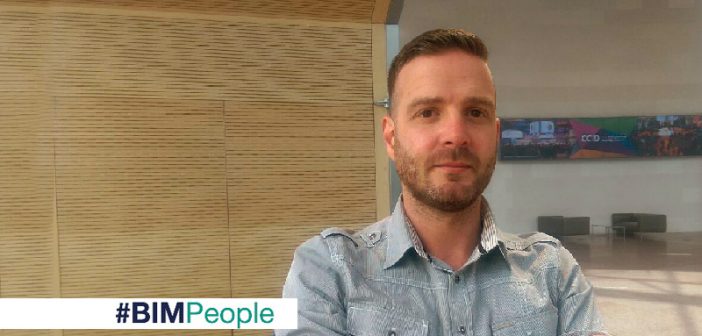Peter Mc Donnell is an Architectural Technologist with a background in construction technology having graduated from Dublin Institute of Technology (DIT) in 2002. Peter has worked in both the private and public sector for 20 years. He completed his Royal Institute of Architects of Ireland (RIAI) Architectural Technologist exams in 2011 and has been working in a project management role with the University of Dublin, Trinity College since 2005. Peter is currently an Assistant Architectural Services Officer while undertaking the role of BIM Manager/Client BIM Representative for the delivery of capital projects.
Peter talked to BIMIreland.ie about his work at Trinity College and his education and training, including his Master of Science in Construction Informatics undertaken at DIT.
Please tell us how you got interested in BIM?
I became interested in Building Information Modelling (BIM) while working for the University. Moving to the client side I began to fully appreciate how information was absolutely key to successfully and efficiently managing assets. The quality of information being handed over by design teams did not meet the requirements of The Estates and Facilities Department, and poor internal information management was leading to problems with general facilities management, maintenance, capital and refurbishment projects and space planning. I realised that there must be a better way of doing things and that is when I undertook my own research and discovered BIM and the possibilities it presented to improve the entire Architecture, Engineering, and Construction (AEC) industry. While on a career break in 2009/2010 I travelled to Australia where I worked for an Architect who had implemented BIM on some large urban planning and infrastructural projects in Sydney and was using BIM software, and that really opened my eyes to the potential of BIM.
Can you tell us about your work with BIM at Trinity College?
At present, I am undertaking the role of BIM Manager/Client BIM Representative for a number of large capital projects. I have developed and issued the University’s first Employer’s Information Requirements (EIR) and Supply Chain Capability Summary (SCCS) documents for the new Trinity Business School (TBS) development, the University’s first BIM Level 2 project, and hope to issue our second EIR and SCCS documents for the planned Oisin House Redevelopment project. I am overseeing client information management and technical requirements in accordance with PAS1192-2/3/4 and 5, ensuring design teams align with the EIR and BIM Execution Plan (BEP) as well as ensuring the BIM Protocol and Model Production Delivery Table (MPDT) support the BEP.
Please tell us about the projects that you have worked on at Trinity College?
The new Trinity Business School (TBS) development is a 10,950m² nine-storey (seven overground and two lower-level basement floors) building which incorporates a 600-seat auditorium, exhibition space, 200-seat restaurant and administrative services with a projected contract value of €70m. As well as this exciting project, I am working on the Oisin House Redevelopment to provide student accommodation and a support services centre and the Engineering, Energy, and Environment Institute (E3) Development which is a state-of-the-art research and teaching facility. I am specifying the University’s requirements for ‘Scan-to-BIM’/point cloud surveys which will initially be used throughout the design and construction phases of these capital projects. I helped set up the Department’s ‘BIM Working Group’ to identify our BIM goals and uses with a view to linking BIM to a new Computer Aided Facility Management (CAFM) software solution. BIM is a disruptive technology and there is a natural resistance to it, however, although BIM implementation within the University is at an early stage and a lot of hard work has gone into reviewing and improving traditional practices, the University will now see the benefits that BIM can offer and that gives me great satisfaction knowing that my knowledge and experience with BIM can serve to improve both the academic and administrative areas of this Higher Education Institute.
You have a very interesting CV. Can you tell us about your work with BIM and other technologies in your previous roles?
My experience with BIM commenced with my current employer. I wanted to upskill when I returned from Australia and I requested to undertake training with ArcDox in 2011, which the Estates and Facilities Department supported me with. I successfully achieved my certification in the BIM Management, Revit Essentials, and Revit Families training courses. I also recently completed the Autodesk Revit and Level 2 BIM Certification training course at the Dublin Institute of Design and I would highly recommend these courses to anybody looking to upskill or educate themselves in BIM software and processes. Previous to this I would have used AutoCAD in my roles as an architectural technologist and CAD technician prior to that. I started off working as a CAD technician in Dublin in the late nineties and remember well the transition from drawing board to the use of computers for drafting purposes, and there was resistance to this change at the time I recall also. My exposure to computers to assist in design and manufacturing actually started when I was in secondary school when we were taught how to use an MS-DOS version of CAD/CAM software in engineering classes.
Can you tell us about your enrolment on the Master of Science in Construction Informatics at DIT, and what attracted you to the course?
Once I had a good knowledge and understanding of BIM software I wanted to re-educate myself further to help develop my overall knowledge of BIM, BIM management, BIM standards, Lean Construction, emerging and innovative technologies and the processes associated with these. I found the Master of Science in Construction Informatics course at DIT Bolton Street. After speaking with Suzanne Purcell (CitA) and Alan Hore (CitA/DIT) and having read up on the different modules related to data/information management and BIM execution planning, I realised that these were particularly relevant to my work and I have been utilising these new skills in my role as BIM Manager.
What were the main benefits of the course for you?
The entire Master of Science in Construction Informatics course has benefitted me greatly. When I decided that BIM implementation and management was the route that I wanted to take in my career, once I had started undertaking the modules I could immediately apply them to my work. Collaborating with fellow students on group projects helped me understand how different disciplines approached BIM as we all came from slightly different backgrounds (project management, engineering, architecture, quantity surveying, and building surveying etc.). The course is demanding yet rewarding and learning how to use different BIM software while undertaking various assignments was a bonus. The main benefit for me was the knowledge the course provided me with to allow me to undertake the role of BIM Manager for a large client and I have to thank, in particular, Michael Earley (Scott Tallon Walker Architects/DIT), Barry Mc Auley (DIT) and Tomo Cerovsek (University of Ljubljana) for sharing their knowledge along the way. The course has also improved my academic writing skills, and I am currently completing my final dissertation titled “The Adoption of Building Information Modelling to Improve Existing Teaching Methods and Support Services Within a Higher Education Institute in Ireland”. I recently published a paper at the 2015 CitA BIM Gathering, co-authored with Professor Roger West of the Department of Civil, Structural and Environmental Engineering at the University of Dublin, Trinity College. Information management is something I have a real passion for and the course has helped me achieve my goals and further my career.
What locations and jobs have fellow classmates gone to work in?
I have kept in contact with some of my fellow classmates and they are mostly in a similar position to me undertaking BIM management and co-ordination roles. I am aware of a former student who recently commenced employment as Project Information Manager/Project Coordinator with the Grangegorman Development Agency which is a really exciting and interesting development to be involved in.
What advice would you give people interested in the course?
By furthering my education in the management of BIM processes I have opened up more opportunities for myself, both in Ireland and internationally. If you are thinking of upskilling and have an interest in BIM management then I would highly recommend this course. My advice to anybody interested in the course would be to be ready to dedicate yourself to the hard work required on the course and you will see the results. By surrounding yourself with like-minded people you can achieve your goals, ambitions and learn new ways of thinking, new ways of working, and if you are focused enough you can also pick up new BIM software skills to compliment your new BIM management skills.
Do you have any recommendations for Irish architects, architectural technicians, and technologists adopting BIM?
My recommendation would be to start small but aim big. Don’t bite off more than you can chew in the early stages of adopting BIM and read some BIM related literature before you set out on your BIM journey. There are some really good sources of information out there and even a simple exercise such as attending CitA events, or if you are interested in BIM software look up the Revit Users Ireland Group (RUIG). Being in the company of others who know that there is a better way of designing, constructing and managing built assets can provide you with the necessary tools and encouragement to make the change. The AEC industry needs to change and is changing. This change may appear to be slow to happen but it is happening.
The contents of this site are subject to copyright laws and may not be reproduced in any form without the prior consent of the publishers. The views expressed in articles do not necessarily represent those of the publishers.




